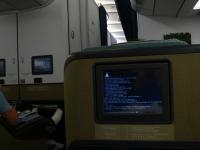Catégories: "Informatique"
Ma vie (piouf)
Mai 25th, 2006De retour en France début avril, ces deux derniers mois ont été consacrés à la recherche d'un boulot et d'un appartement.
J'ai maintenant les deux et qui ont tout pour me plaire.
Niveau de l'appartement, je me suis installé avec mon amie dans un trois pièces situé à Paris (20 ème) près de la place de Nation. Super appartement, content et bien chez nous dedans. Bon, le seul problème est que l'on a pas encore l'ADSL... Donc je squate la connexion chez Pimentech.
Pour le boulot, après de longues recherches (cf message précédent), j'ai finalement trouvé exactement le boulot que je recherchais. Je vais intégrer le prestigieux institut qu'est l'INRIA - Institut National de Recherche en Informatique et Automate (pour ceux qui ne connaissent pas, c'est comme le CNRS mais appliqué à l'informatique). Régulièrement classé dans le top 3 de 01 informatique des entreprises préférées des informaticiens.
Je vais être amené à travailler sur le projet Scilab, logiciel de calcul scientifique. Mon travail consistera principalement en les développements multi plates-formes en vue de la réalisation des fonctionnalités de Scilab 5 et la responsabilité des versions UNIX et GNU/Linux du logiciel Scilab. Je sens que je vais bien m'amuser !
Ce fut un retour et une réinstallation en France un peu plus longue que je ne l'avais imaginé mais qu'il est au final bien passé !
Le HDR par Sylvestre
Avril 25th, 2006Depuis que Julien m'a fait découvrir le HDR, j'attendais le moment pour tester cette technique de rendu de photo développé par ILM (Industrial Light and Magic, société de G. Lucas).
| En effet, même sur un sujet assez quelconque, le rendu est pas (trop) mal. Le principe consiste à prendre plusieurs fois la même photographie (3 pour mon exemple) avec des réglages différents (pour moi, j'ai juste changé la durée d'ouverture). |
Celui qui devine où se trouve cet immeuble a gagné un billet avec sa photo sur mon blog !
OpenCascade : How to make money with free software ?
Avril 11th, 2006I wrote this article 6 mois ago. I was waiting for some stuffs around this. However, it is too late so I release it.
My main concern about free software as a way of doing business is "how do you make money out of it ?".
Unfortunatelly, I still don't see any solution ... Of course, it is possible by selling services, maintenance, help, more (costly) advanced version, side development (usually proprietary) but it is not doing money only on free software/development.
Let's me describe on of the solution that uses Opencascade, a former department of Matra.
They produces for a quite long time (about 10 years) a big project called "Open CASCADE". It is a framework used to modelise, visualise 3D models (and many other things that I hardly understand)... It has an aspect of gas factory ("Usine à gaz" as we say in French) because the size/age/complexity of the project. However, it is a very convenient way of doing 3D (many famous corporations use it).
At work, I am working on a project launched by the BRGM (Bureau de recherche géologique et minière ... the equivalent of the french CNRS but for earth sciences) about 10 years ago. The aim of the project is to provide to geologists and geophysists a way of representing the underground. The corporation where I work is doing the work of adding new features, packaging and selling the software. For this project, we use Opencascade.
My work on this project was to provide a visualisation of drillholes in a 3D space (holes that are dug in the ground to get the geological structure of the underground). Basically, I was supposed to represent a (drunk) worm hole from a serie of points.
I tried many way (from the ugliest to the sharpest) but I found some problems with my favorite. When I used too much points, the framework start to reject me (technical description is following my message). As I don't like when a software rejects me, I spent time one this issue (I thought that it was my fault because it is a quite basic feature in the software). I finally successed to isolate the issue and send a kind of SOS/bug report to someone at OpenCascade.
This request cost us 2 units of support from our contract.
Then, one week after, they get back to us with a "There is a bug in Pipe algorithm.". OK, cool. I was a bit proud to find a bug in this kind of big software (for the courageus/crazy, the reason of the bug is : "This bug is caused by complex structure of the curve approximated from 14 (15) points (some discontinuities of derivatives of high levels). Such structure of the curve causes turbulence of the local coordinate system of section along the curve. That is why the algorithm can not build a pipe where the section is orthogonal to the curve in each point all along the curve.", obvious no ?). However, I was expecting a small patch which will fix the issue and a "thank for the bug report". Instead of this, I saw :
The bug fix production can be started after your confirmation.
Please note that the standard price of a query is 15 units of your support program.
OK, now, I know how they make cash (at least a part of it).
You submit what you think to be a bug, it costs you 2 units. They confirm that is a bug, you have to pay 15 units to get the fix. Otherwise, you have to wait for the new release planned whenitwillbeready.
I am not saying it is a bad solution (and I do understand why they do that ... it is called support) but it could be more respectful for the user who spent many time to isolate a bug and report it and consequently helped to improve their software...
(For their defense, they provided me a workaround for my issue).
Monitoring a specific virtualhost apache
December 29th, 2005Monitoring apache quite easy. There are plenty of solutions to do that. When it comes to monitore virtualhost one by one, it starts to be difficult. Of course, there is always the solution of using stats softwares but usually, it is not really time and doesn't give a quick and efficient overview.
Here comes mod_watch. A quite old module for Apache (1.3 & 2.0). Basically it monitores the incoming/outcoming traffic and the requests.
There is no debian package for this module. However, it is very easy to install.
apt-get install apache-dev
tar -zxvf mod_watch318.tgz
cd mod_watch-3.18
make install
Edit /etc/apache/modules.conf
And add in it :
LoadModule watch_module /usr/lib/apache/1.3/mod_watch.so
Edit /etc/apache/httpd.conf
Add :
<IfModule mod_watch.c>
# Allows the URL used to query virtual host data:
#
# http://www.snert.com/watch-info
#
<location /watch-info>
SetHandler watch-info
Order allow,deny
Allow from hostname
</location>
# Intended for debugging and analysis of shared memory
# hash table and weenie files:
#
# http://www.snert.com/watch-table
#
<location /watch-table>
SetHandler watch-table
Order allow,deny
Allow from hostname
</location>
</IfModule>
Stop & start apache (not a restart)
/etc/init.d/apache stop && /etc/init.d/apache start
For each virtualhost, you should be able to see a line containting this kind of data :
sylvestre.ledru.info 49 0 499775 39 9 1 0.000 136656176 3221223448
This means :
| sylvestre.ledru.info | target name |
| 49 | uptime in second |
| bytes received from requests | |
| 499775 | bytes sent |
| 39 | number of requests received |
| 9 | number of documents sent |
| 1 | number of active connections |
| 0.000 | approx. 5 minutes average of bytes sent per second |
| 136656176 | bytes sent during the current 5 minutes period |
| 3221223448 | start time() of the current 5 minutes period |
This data are meant to be retrieve by MRTG thought the mod_watch client in order to produce graphs, ie :
# ./mod_watch.pl http://sylvestre.ledru.info/watch-info
0
2012653
11.31
sylvestre.ledru.info
This returns the number of bytes out.
Or
# ./mod_watch.pl -f ifRequests,ifDocuments http://sylvestre.ledru.info/watch-info
241
80
13.02
sylvestre.ledru.info
This returns the number of requests and documents.
Finally, as the developer knows that ITs are lazy, he made a script which will automatically create an MRTG configuration file from the apache configuration (I made a small patch in order to monitore also the documents/requests with this script and fixes a bug with mrtg indexmaker)
wget http://sylvestre.ledru.info/howto/mod_watch/patch_apache2mrtg.diff
patch < patch_apache2mrtg.diff
Add Workdir: /path/to/www/ for the output dir
./apache2mrtg.pl /etc/apache/httpd.conf > /etc/vhosts_mrtg.cfg
Caution ! apache2mrtg.pl will parse ALL the virtualhost. Even those with htaccess login/password and then won't be able to access to the watch-info files. Remove them from the vhosts_mrtg.cfg file.
There is many solution to customize the value & data. Check out the documentation here : http://www.snert.com/Software/mod_watch/.
Advantages :
* Quite easy to install, configure & maintain
* Quite fast
* Make very easy the task to find which virtualhost takes all the bandwith.
Disavantages :
* Impact on the performance ?
* No monitoring of CPU / Memory
* Based on headers (ie, if I start a download of 200 mo and I stop at the beginning, it will count 200 mo... Problem Described here)
Next tasks :
* Patch the software to add CPU & Memory monitoring PER virtualhost or find a module which does that.
* Find a way to fix the headers issue.
* Add the total bytes transferts
Edit : Comments closed. Thank you spammers !
Flying tux
Décembre 13th, 2005Lors de mon vol Melbourne => Hong Kong, le système de vidéo de la business class avec Cathay Pacific est tombé en rade. Donc on a patienté pour que ça revienne et on a vu que le système tourne sous Linux. Le problème était visiblement que le serveur de fichier NFS était en rade et donc que les clients n'arrivaient pas à le monter...
Voila la photo... Je suis un peu passé pour un cinglé à prendre ça en photo dans l'avion.

Linux / Tux used by Cathay Pacific
